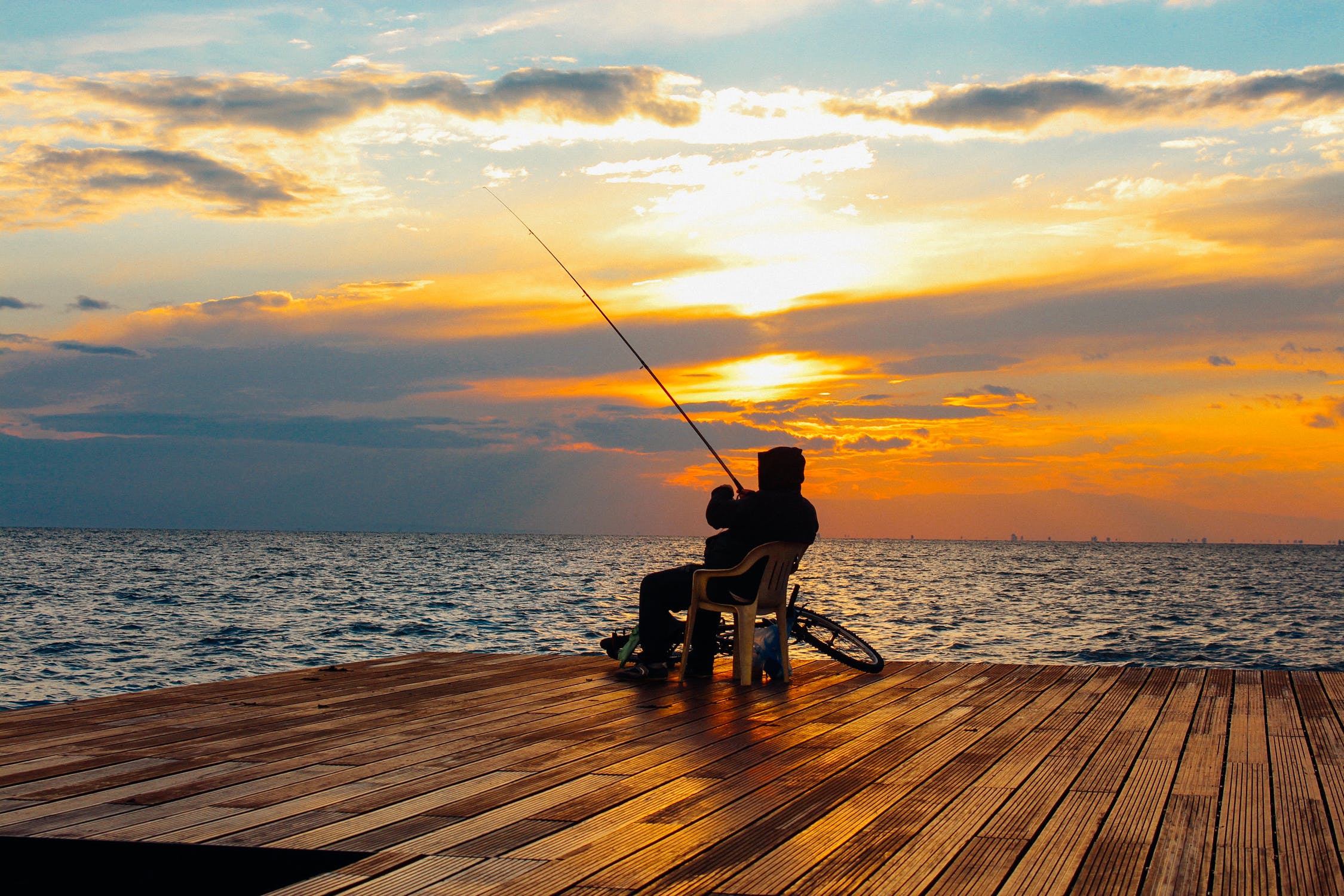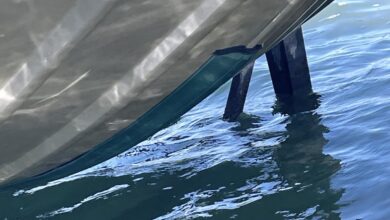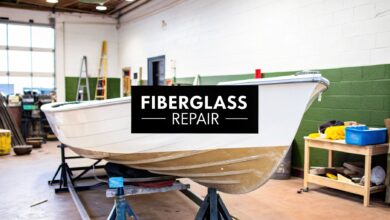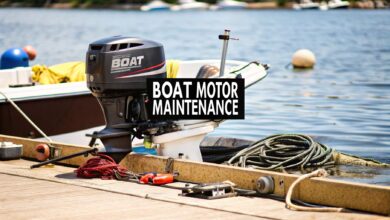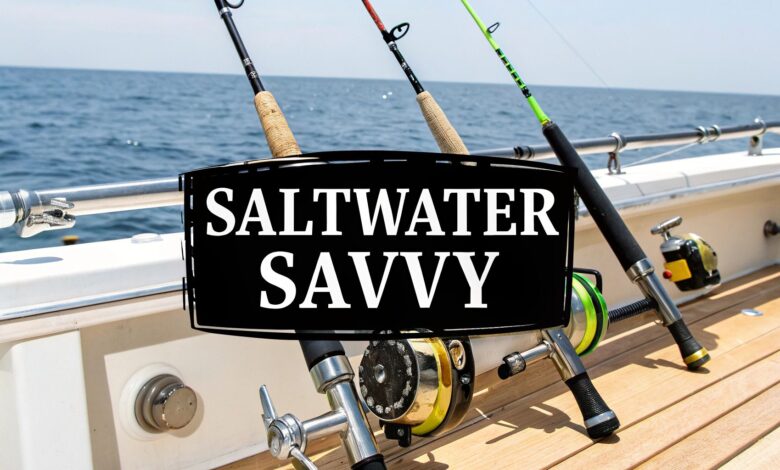
Saltwater fishing is a thrilling pursuit that blends skill, strategy, and a deep respect for the ocean's rhythms. For many, the allure of the open water and the promise of a powerful fight is irresistible. Yet, the difference between a frustrating day and a deck full of fish often comes down to knowledge. Generic advice won't cut it when you're facing shifting tides, wary predators, and the unforgiving marine environment.
This guide moves beyond the basics, offering a curated roundup of eight expert-backed saltwater fishing tips designed to provide actionable insights. Whether you're casting from a pier, navigating inshore flats, or venturing offshore, these strategies will refine your technique, enhance your decision-making, and significantly increase your odds of success.
We'll explore how to master tidal movements, select and present bait like a pro, read the water for hidden hotspots, and ensure every trip is both productive and safe. Get ready to transform your approach and make every moment on the water count. This collection of practical tips is built to help you land more fish, plain and simple.
1. Mastering the Tidal Dance: How Tides and Timing Dictate Success
More than any other variable, tides act as the primary engine driving activity in the marine ecosystem. These daily water level fluctuations are the single most influential factor in saltwater fishing, creating predictable feeding patterns for virtually all coastal species. Successful anglers don't fight the tide; they learn to read its rhythm and use it to their advantage, treating it as a natural dinner bell that concentrates bait and predators.
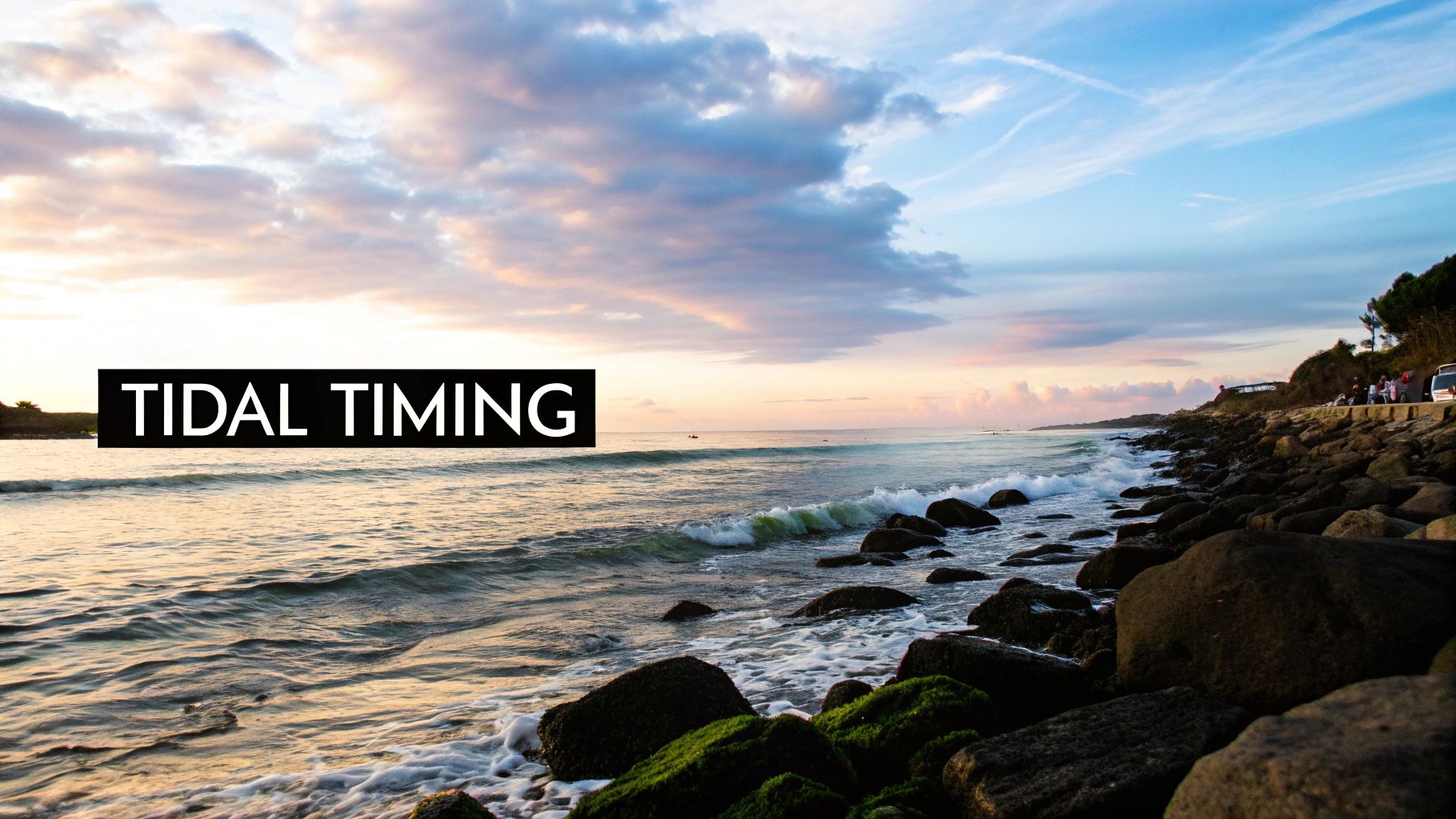
The key is moving water. A stagnant, slack tide often results in slow fishing, as there is no current to move baitfish or stimulate predators to feed. The most productive fishing almost always occurs during the two hours leading up to and following a high or low tide, a period often called the "bite window." This is when currents are strongest, creating opportunities for game fish.
Why This Saltwater Fishing Tip Matters
Understanding tidal movement transforms you from a hopeful caster into a strategic hunter. Instead of guessing, you can predict with high accuracy when and where fish will be actively feeding.
- Incoming Tide: As the tide rises, it pushes clean, oxygenated water and baitfish inshore. Striped bass in the Chesapeake Bay, for example, move into coves and estuaries on an incoming tide to ambush disoriented bait.
- Outgoing Tide: A falling tide flushes crabs, shrimp, and small fish out of their protective cover. This is a prime time to target redfish in Louisiana marshes, as they stage at the mouths of creeks to intercept this easy meal.
How to Implement This Strategy
- Use Modern Tools: Download a tide prediction app like Tide Charts or Fishing Points. These tools provide real-time data on tidal heights and current speeds right on your smartphone.
- Focus on Structure: During periods of strong current, fish use structure to hide and ambush prey. Concentrate your efforts on points, jetties, oyster bars, and drop-offs where the current is forced to change direction.
- Keep a Log: Track your successes and failures. Note the tide phase, location, wind, and time of day for each fish you catch. Over time, this data will reveal powerful patterns specific to your local waters.
2. Proper Bait Selection and Presentation
While tides set the stage, the bait you offer is the star of the show. The most fundamental rule in saltwater fishing is to “match the hatch,” meaning you present a bait that local predators are actively feeding on. A game fish’s brain is hardwired to recognize the size, shape, scent, and movement of its natural forage. Presenting the right offering is the difference between a curious glance and an aggressive strike.
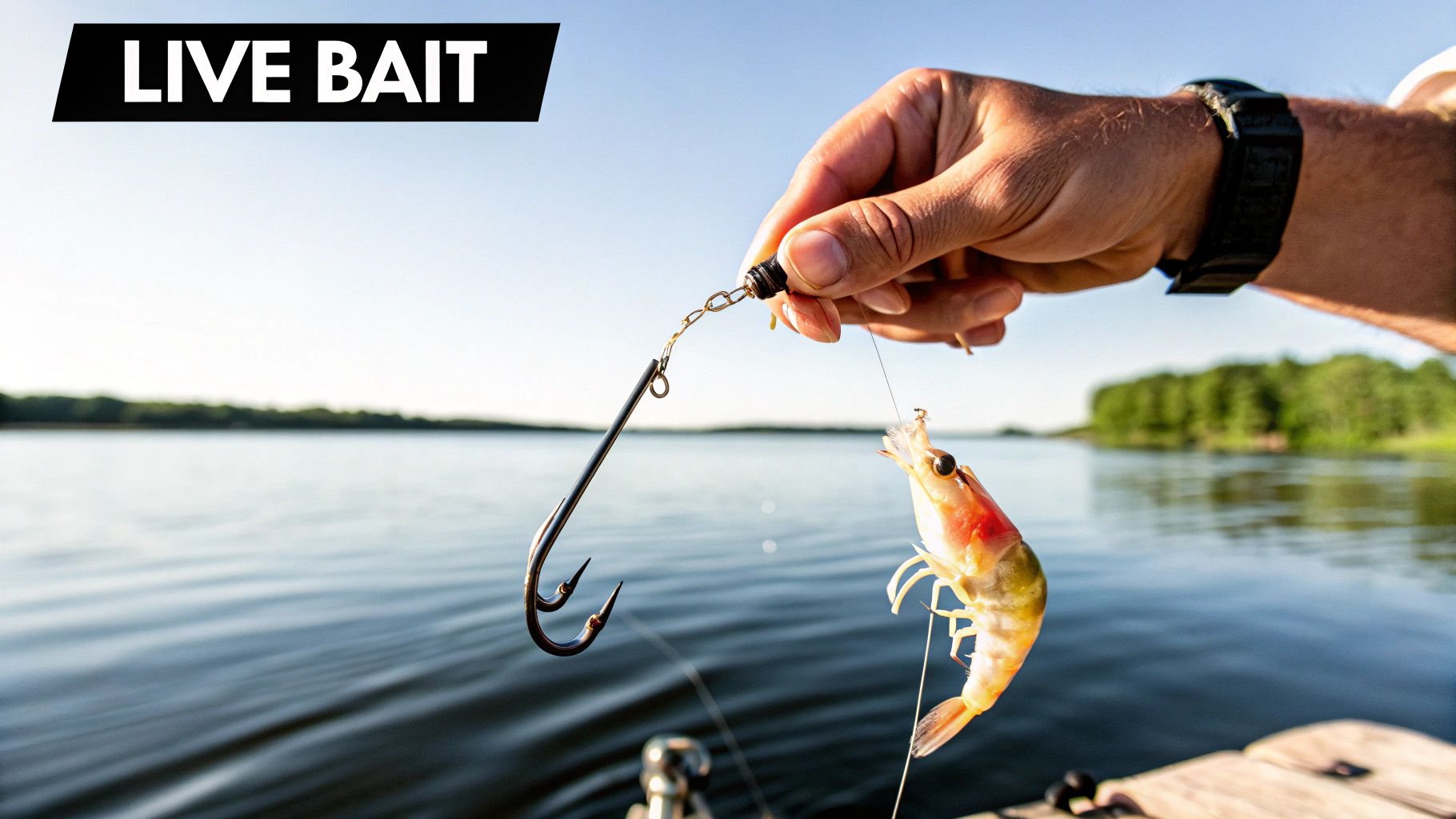
Live bait often holds a distinct advantage, as its frantic movements and natural scent are powerful attractants that artificial lures struggle to replicate. However, even the liveliest bait is useless if presented unnaturally. Legendary anglers like Flip Pallot built their careers on the principle that a perfectly presented bait, whether live or artificial, is the key to fooling wary, pressured fish.
Why This Saltwater Fishing Tip Matters
Proper bait selection and presentation directly appeal to a fish's predatory instincts. By offering what they expect to eat, you remove suspicion and trigger a natural feeding response. This is one of the most effective saltwater fishing tips for turning a slow day into a productive one.
- Inshore Species: Redfish and snook in Florida's mangroves are conditioned to hunt shrimp. A live, free-lined shrimp presented near structure is an almost irresistible meal.
- Offshore Pelagics: High-speed predators like tuna and mahi-mahi feast on schools of sardines or pilchards. Using these for chum and as hook baits creates a feeding frenzy.
- Bottom Dwellers: Species like grouper and snapper often rely on scent. A chunk of fresh squid or a live pinfish sent to the bottom of a wreck or reef is highly effective.
How to Implement This Strategy
- Keep Bait Healthy: Use an aerated livewell or bait bucket with properly circulated, cool water. A sluggish or dead bait loses its appeal quickly, so replace it often.
- Match the Hook to the Bait: Use the smallest, lightest hook possible that still provides the necessary strength. This allows the bait to swim more naturally and makes the terminal tackle less visible to sharp-eyed fish. Circle hooks are excellent for live baiting, as they ensure a solid hookset in the corner of the jaw, improving fish survival.
- Observe Local Forage: Before fishing, spend time at local docks or bait shops to see what baitfish are prevalent. Pay attention to what birds are diving on; they are often targeting the same bait as the game fish. For more insights, you can review some deep sea fishing tips for beginners on boating-articles.com.
3. Reading Water and Structure
Beyond tides, the physical environment beneath the surface dictates where fish live, feed, and seek shelter. Structure is any feature that breaks up the monotony of the bottom, from a submerged rock pile to a sprawling reef. Learning to identify these features by reading visual cues on the water's surface is a fundamental skill that separates novice anglers from seasoned veterans. It's the art of seeing the invisible, translating subtle surface changes into a clear map of the underwater world.
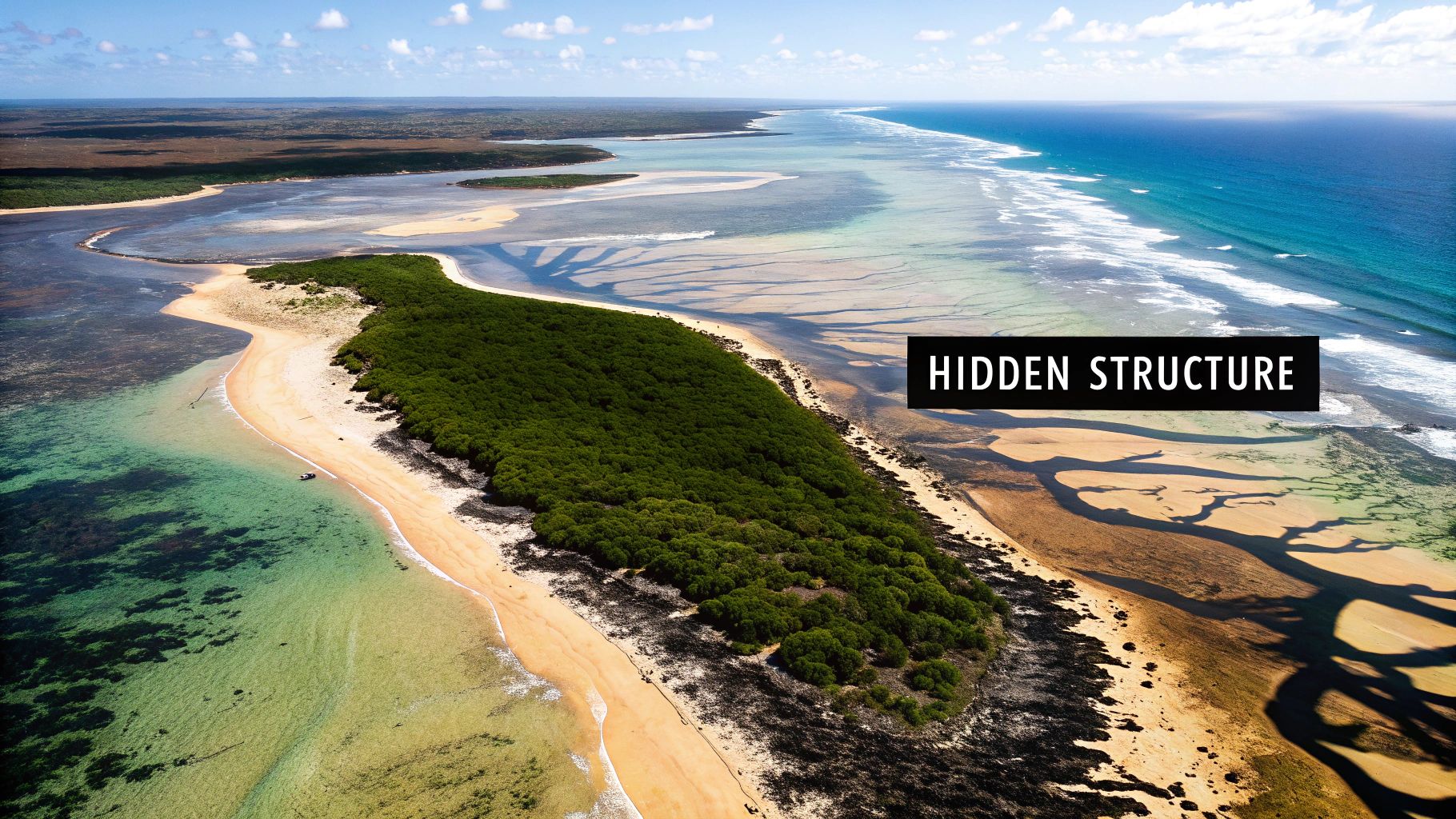
Fish are drawn to structure for two primary reasons: safety and food. It provides cover from larger predators and creates ambush points where they can intercept prey carried by the current. A seemingly random patch of rippled water or a subtle color change often signals a productive drop-off, oyster bar, or weed line below, concentrating game fish in a predictable zone.
Why This Saltwater Fishing Tip Matters
This skill allows you to locate fish habitats without relying solely on electronics. By interpreting surface signs, you can effectively pinpoint high-potential spots, making your casts count and minimizing time spent in barren water. It’s one of the most crucial saltwater fishing tips for consistently finding fish.
- Rip Lines: The visible seam where two currents meet is a magnet for life. These lines trap floating debris and bait, attracting predators like mahi-mahi offshore and snook along coastal inlets.
- Oyster Bars and Grass Flats: In shallow estuaries, these structures provide critical habitat for crabs, shrimp, and small fish. A slight change in water texture or color can reveal their location, which is a prime hunting ground for redfish and speckled trout.
- Wrecks and Reefs: Offshore structure creates an entire ecosystem. Even if you can't see it, signs like nervous water or baitfish schools on the surface can indicate its presence below, holding species from snapper to cobia.
How to Implement This Strategy
- Wear Polarized Sunglasses: This is non-negotiable. High-quality polarized lenses cut through surface glare, revealing bottom contours, submerged grass, and even the fish themselves.
- Study Nautical Charts: Before you even leave the dock, analyze nautical charts to identify drop-offs, ledges, and known structure. Cross-reference this with what you observe on the water to build a complete picture.
- Fish the "Up-Current" Side: When you locate structure, position your boat so you can cast your bait or lure up-current and let it drift naturally past the ambush point. This presents a more realistic offering to waiting fish. Understanding how to properly position and anchor is key, and you can learn more about how to anchor your boat on boating-articles.com to master this technique.
4. Tackle and Equipment Selection: Your Direct Link to the Fish
Saltwater fishing places extreme demands on your gear. The corrosive environment and the sheer power of marine species mean that standard freshwater tackle simply won't suffice. Choosing the right equipment isn't about having the most expensive setup; it's about selecting durable, purpose-built tools that match your target species and fishing style, ensuring reliability when a trophy fish is on the line.
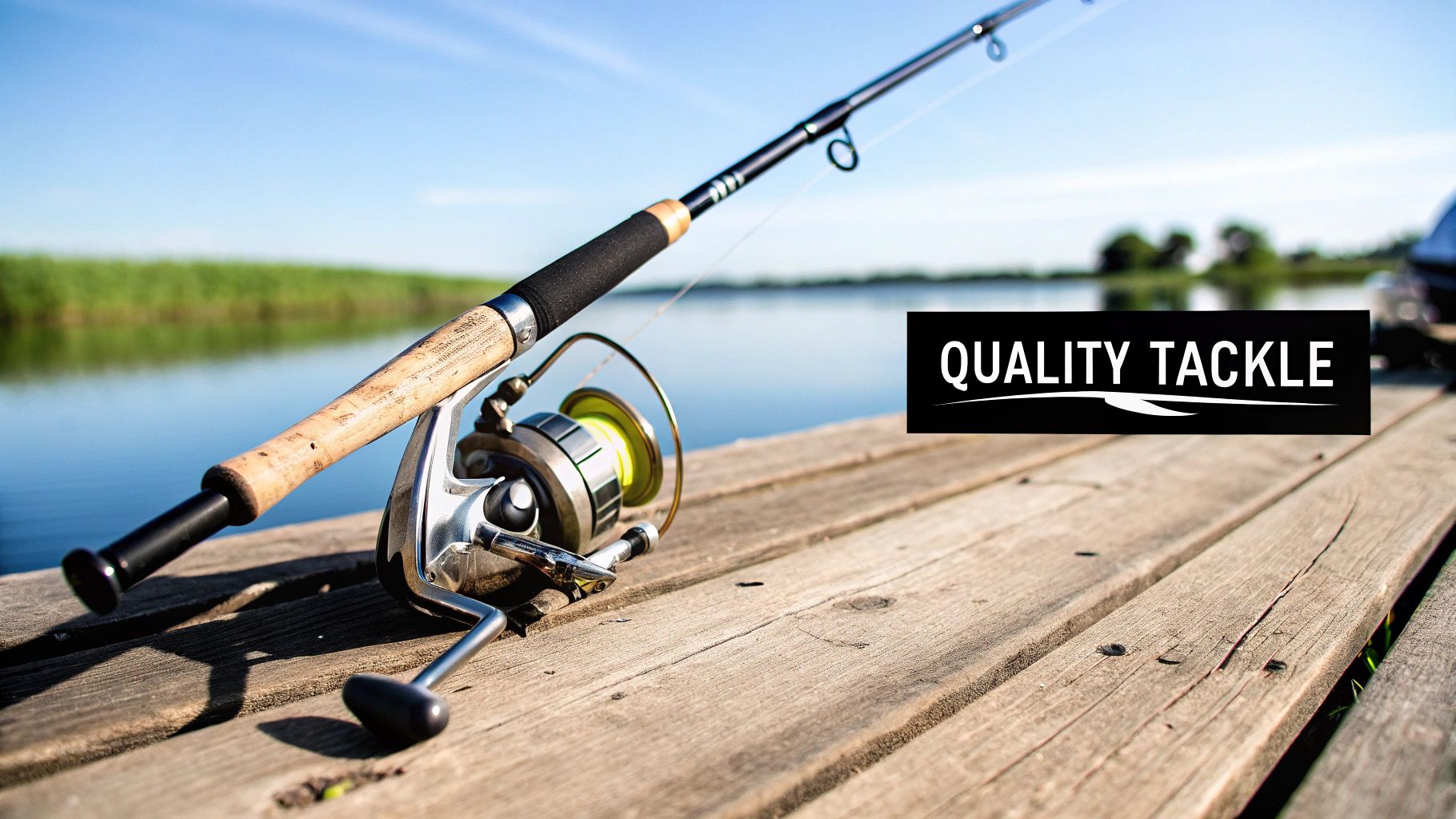
From powerful conventional reels designed for offshore trolling to lightweight spinning setups for inshore flats, every component must work in harmony. Quality gear, like the legendary Penn International series for big game or the refined Shimano Stella for inshore battles, is engineered with sealed drags and corrosion-resistant materials. This investment pays dividends in longevity and performance, preventing catastrophic failures during a critical fight.
Why This Saltwater Fishing Tip Matters
Proper tackle selection is the foundation of successful angling. Using gear that is too light risks losing fish and tackle, while gear that is too heavy can reduce casting distance and sensitivity, leading to missed bites. A well-balanced setup increases your chances of a successful hookup and landing.
- Offshore Trolling: For powerful species like marlin and tuna, heavy-duty conventional reels such as the Daiwa Saltiga are essential. They provide the line capacity and drag power needed to handle long, blistering runs.
- Inshore Spinning: Targeting species like snook or bonefish requires finesse. A lightweight, sensitive rod, like those in the St. Croix Avid Inshore series, paired with a smooth spinning reel allows for precise casting and subtle lure presentation.
How to Implement This Strategy
- Rinse Everything, Every Time: After each trip, thoroughly rinse all rods, reels, lures, and tools with fresh water. This simple habit is the single most effective way to combat saltwater corrosion and extend the life of your equipment.
- Match Components: Ensure your rod's power rating, your reel's size, and your line's pound test are all compatible. An unbalanced setup will cast poorly and can lead to rod or reel failure under stress.
- Invest in Quality Hardware: Don't overlook the small stuff. Use high-quality, corrosion-resistant ball-bearing swivels, snaps, and hooks. Cheap terminal tackle is a common point of failure.
- Carry Backups: Equipment can and does fail. Always bring a backup rod and reel, especially on longer trips. Having a spare ready can save a day on the water.
5. Dialing in Your Connection: The Critical Choice of Line and Leader
The connection between you and a powerful saltwater fish is only as strong as its weakest link, which is often the line and leader. In an environment filled with abrasive structures, sharp-toothed predators, and crystal-clear water, your line system is not a place to compromise. Selecting the right combination of main line and leader material is a fundamental saltwater fishing tip that directly translates into more landed fish and fewer heartbreaking break-offs.
The main line on your reel and the leader at the terminal end serve different purposes. The main line provides casting distance and sensitivity, while the leader offers stealth and abrasion resistance. A well-balanced setup leverages the strengths of different materials, creating an optimized system for specific targets and conditions. Professional anglers from Berkley and Seaguar pro-staffs obsess over these details because they know it's a game of inches and pounds.
Why This Saltwater Fishing Tip Matters
Proper line and leader selection is a non-negotiable skill that prepares you for the specific challenges of the marine world. It’s about anticipating the fight and the environment before you even make a cast.
- Stealth vs. Strength: A nearly invisible fluorocarbon leader is essential when sight fishing for wary bonefish on clear flats, as it won't spook the fish. Conversely, a steel or heavy monofilament leader is required to withstand the razor-sharp teeth of a king mackerel or barracuda.
- Sensitivity and Shock Absorption: A braid main line offers zero stretch, allowing you to feel the slightest tap from a flounder in deep water. Pairing it with a monofilament leader adds a bit of stretch, creating a crucial shock absorber that prevents hooks from tearing out during a violent headshake.
How to Implement This Strategy
- Match Leader to Target: Carry spools of fluorocarbon and monofilament leader in various strengths (e.g., 20lb, 40lb, 60lb). If you're targeting toothy critters, have pre-made wire leaders ready to go.
- Master Your Knots: The connection between your main line and leader is paramount. Learn to tie a strong, slim knot like the FG Knot or the Double Uni Knot to ensure it passes smoothly through your rod guides.
- Check for Nicks Constantly: After every fish or snag, run your fingers along the last few feet of your leader. Any roughness or nick is a weak point. Don't hesitate to cut it off and retie; it's a small price to pay to avoid losing a trophy fish.
6. Reading the Sky: How Weather and Water Conditions Impact Fish
Beyond tides and currents, the daily weather serves as a secondary, yet equally powerful, director of fish behavior. Factors like barometric pressure, wind, cloud cover, and water temperature create specific windows of opportunity or slowdown. Learning to interpret these atmospheric and aquatic cues allows an angler to adapt their strategy on the fly, turning a potentially slow day into a productive one.
The core principle is that fish are highly sensitive to environmental changes. A falling barometer ahead of a storm often signals an impending change in conditions, triggering an aggressive feeding response in many species. Conversely, the high, clear skies and stable pressure following a cold front can lead to lethargic fish that are much harder to entice.
Why This Saltwater Fishing Tip Matters
Understanding weather patterns is a critical layer in the complex puzzle of saltwater fishing. It provides context for fish behavior, helping you decide not just when to go, but also where to fish and what techniques to use once you are on the water.
- Barometric Pressure: A dropping barometer is often the best time to fish, as it spurs fish into a pre-storm feeding frenzy. This is a well-known trigger for species from snook in Florida to bluefish in the Northeast.
- Wind Direction: Wind creates current and pushes baitfish. A consistent onshore wind will stack bait along windward shorelines and points, concentrating predators looking for an easy meal.
- Cloud Cover: Overcast days reduce light penetration, making shallow-water species less wary and more willing to roam from cover. This is a prime time for sight-fishing for bonefish on the flats or throwing topwater lures for speckled trout.
How to Implement This Strategy
- Monitor Weather Apps: Use apps like Weather Underground or FishWeather to track barometric pressure trends. Look for a steady drop in pressure (measured in millibars or inches of mercury) in the 24 hours before your trip.
- Fish the Windward Side: Don't hide from the wind. Target points, shorelines, and structure on the side of the lake or bay where the wind is blowing into. This "wind-blown bank" will hold the most active, feeding fish.
- Adjust for Temperature: After a cold front, fish often move to deeper, more stable water to find warmer temperatures. Downsize your lures and slow your presentation to coax bites from these less active fish.
7. The Ethical Angler: Mastering Fish Handling and Conservation
The thrill of the catch is only one part of the angling experience; what happens after the fight is just as crucial. Proper fish handling and conservation are the hallmarks of a responsible angler, ensuring the health of the fish you release and the long-term sustainability of the fishery. Catch and release is a powerful conservation tool, but only when executed correctly to minimize stress and injury to the fish.
This approach is centered on understanding fish biology and the factors that cause them harm, like prolonged air exposure, loss of protective slime, and internal injuries from improper handling. By adopting best practices, you directly contribute to the survival of released fish, allowing them to grow, spawn, and be caught again, thus preserving the resource for future generations.
Why This Saltwater Fishing Tip Matters
Ethical handling transforms you from a simple participant into a steward of the marine environment. It's a fundamental saltwater fishing tip that ensures the sport we love remains vibrant. A fish that swims away healthy is a victory for the entire ecosystem.
- Circle Hooks: These are mandated in many fisheries for a reason. Their unique design causes them to hook the fish in the corner of the mouth, dramatically reducing deep-hooking and internal organ damage, which increases post-release survival rates significantly.
- Reduced Stress: Keeping a fish in the water while dehooking, using wet hands to handle it, and providing horizontal support protects its vital slime coat and internal organs. Holding a heavy fish vertically by its jaw can damage its spine and jaw.
How to Implement This Strategy
- Gear Up for Release: Invest in the right tools. A rubberized, knotless landing net prevents scale and slime loss. Long-nosed pliers or a dedicated dehooking tool allow for quick and safe hook removal without damaging the fish's mouth.
- Handle with Care: Always wet your hands or gloves before touching a fish to protect its sensitive slime coat, which acts as its primary defense against infection. Support the fish's body horizontally under the belly and near the tail.
- Revive and Release: Before letting go, face the fish into the current to help it "breathe," gently moving it back and forth to force oxygenated water over its gills. Release it only when it can swim away strongly on its own power.
8. Prioritizing Safety and Preparation: The Most Important Catch of the Day
The ocean is a powerful and unpredictable environment, and the most critical element of any successful saltwater fishing trip happens before you even leave the dock. Prioritizing safety and preparation isn't just a recommendation; it's a fundamental responsibility. A well-prepared angler understands that conditions can change in an instant, and having the right equipment, knowledge, and plan in place is the only way to mitigate the inherent risks of being on the water.
This proactive approach transforms a potentially dangerous situation into a manageable one. It’s the difference between a minor inconvenience and a true emergency. From sudden squalls to equipment failure, being prepared means you can focus on fishing with confidence, knowing you have a plan for the unexpected.
Why This Saltwater Fishing Tip Matters
Comprehensive safety planning is the cornerstone of responsible angling and is arguably the most crucial of all saltwater fishing tips. It ensures you, your crew, and your vessel can handle adverse situations and return home safely.
- Weather Changes: A calm, sunny morning can quickly turn into a treacherous afternoon with high winds and rough seas. A reliable weather source and the knowledge to interpret it are non-negotiable.
- Medical Emergencies: From a simple hook injury to a more serious medical event, being miles from shore requires self-sufficiency. A well-stocked, marine-specific first-aid kit and the knowledge to use it can be lifesaving.
- Equipment Failure: A dead battery or a failed bilge pump can escalate quickly. Having backup systems and basic troubleshooting skills prevents a minor issue from becoming a catastrophe.
How to Implement This Strategy
- File a Float Plan: Always tell someone on shore where you are going, who is with you, and when you plan to return. This simple act provides a vital safety net if you fail to check in.
- Assemble a Ditch Bag: Keep a waterproof bag with essential emergency items ready to go. Include an Emergency Position Indicating Radio Beacon (EPIRB), a handheld VHF radio, flares, a signaling mirror, fresh water, and high-energy food.
- Check and Maintain Gear: Before every trip, perform a pre-launch check. Test your VHF radio, inspect personal flotation devices (PFDs), and ensure your navigation lights are working. Properly fitting PFDs are essential; you can learn more about how to select a life vest on boating-articles.com.
- Stay Informed: Continuously monitor weather forecasts from reliable sources like the NOAA Weather Radio before and during your trip. Be prepared to change your plans or head back to shore if conditions deteriorate.
Saltwater Fishing Tips: 8-Point Comparison
| Topic | Implementation Complexity 🔄 | Resource Requirements ⚡ | Expected Outcomes 📊 | Ideal Use Cases 💡 | Key Advantages ⭐ |
|---|---|---|---|---|---|
| Understanding Tides and Timing | Moderate – requires research & planning | Low – tide charts/apps readily available | Higher catch rates when timed properly | All saltwater environments, trip planning | Dramatically improves success, widely applicable |
| Proper Bait Selection and Presentation | Moderate – bait maintenance & rigging skills | Medium – live bait and equipment | Increased catch rates, attracts larger fish | Various depths & conditions | Attracts more species, natural bait advantage |
| Reading Water and Structure | High – requires experience & tools | Medium – may need depth finders | Better location selection, less wasted time | All saltwater fishing methods | Predicts fish behavior, improves productivity |
| Tackle and Equipment Selection | Moderate – choosing & maintaining gear | High – quality gear investment | Durable gear, improved fish fighting | Target species-specific fishing | Reduces failures, enhances experience |
| Line and Leader Selection | Moderate – knot knowledge & line choices | Medium – multiple lines & leaders | Reduced break-offs, better casting & invisibility | Clear water & abrasive environments | Prevents lost fish, improves presentation |
| Weather and Water Conditions | Moderate – ongoing monitoring needed | Low – weather apps and instruments | Predicts fish behavior and safety | All saltwater fishing, adapting techniques | Helps optimize timing and safety |
| Fish Handling and Conservation | Moderate – requires technique mastery | Low – additional tools recommended | Increased survival of released fish | Catch and release, conservation focused | Preserves populations, supports regulations |
| Safety and Preparation | Moderate – planning & gear preparation | Medium – safety equipment & training | Prevents accidents, improves confidence | All saltwater fishing, especially offshore | Essential for emergency handling, required gear |
Putting It All Together: Your Blueprint for Success
The vastness of the ocean can feel intimidating, but it operates on a set of predictable principles. The comprehensive saltwater fishing tips detailed in this guide are not just individual tactics; they are the fundamental building blocks of a cohesive and highly effective angling strategy. By understanding how these elements work together, you transform from a passive participant into a proactive hunter, capable of interpreting the environment and anticipating where fish will be and how they will behave.
Think of it as an interconnected system. Your understanding of tides and timing dictates the best moments to be on the water. Your ability to read water and structure tells you precisely where to position your boat. This knowledge, in turn, informs your choice of tackle, line, and leader, ensuring your gear is perfectly matched to the target species and conditions. Finally, your skill in bait selection and presentation is the critical final step that entices a strike. Each piece of knowledge amplifies the others, creating a powerful synergy.
From Theory to Practice: Your Actionable Next Steps
Merely reading about these concepts is not enough. True mastery comes from consistent application and observation. To help you integrate these advanced saltwater fishing tips into your routine, here are some practical steps to take on your very next trip:
- Start a Detailed Fishing Log: Before you even leave the dock, log the date, time, weather forecast, and tide predictions. During your trip, record what baits and lures you used, where you found fish (noting specific structures like points, drop-offs, or wrecks), and the results. Over time, this log will become your most valuable tool, revealing patterns you would otherwise miss.
- Invest Time in Chart Study: Don't wait until you're on the water. Spend an evening studying nautical charts of your target area. Identify potential hotspots, channels, and structure. Cross-reference this with tide charts to visualize how the water will move over these features, creating likely ambush points for predators.
- Create a Post-Trip Checklist: Success isn't just about the catch; it's about longevity. A post-trip routine is non-negotiable. Create a checklist that includes a freshwater rinse for all rods, reels, and tackle, inspecting your line for frays, and verifying your safety gear is ready for the next outing. This habit protects your investment and ensures reliability.
The True Reward of Preparation
Embracing this holistic approach does more than just help you catch more fish. It deepens your connection to the marine environment and builds a quiet confidence that comes from genuine expertise. You will learn to trust your instincts because they are backed by knowledge and experience. The thrill of a screaming drag is intensified when it's the result of a well-executed plan. By dedicating yourself to mastering these foundational saltwater fishing tips, you are investing in a lifetime of safer, more productive, and profoundly more rewarding adventures on the water.
Ready to dive deeper? Your journey to becoming a master angler and boater is just beginning. For expert guides on everything from advanced navigation techniques to maintaining your vessel for peak performance, explore the comprehensive resources at Boating Articles. Visit Boating Articles to access a wealth of information designed to make every moment on the water safer and more successful.
